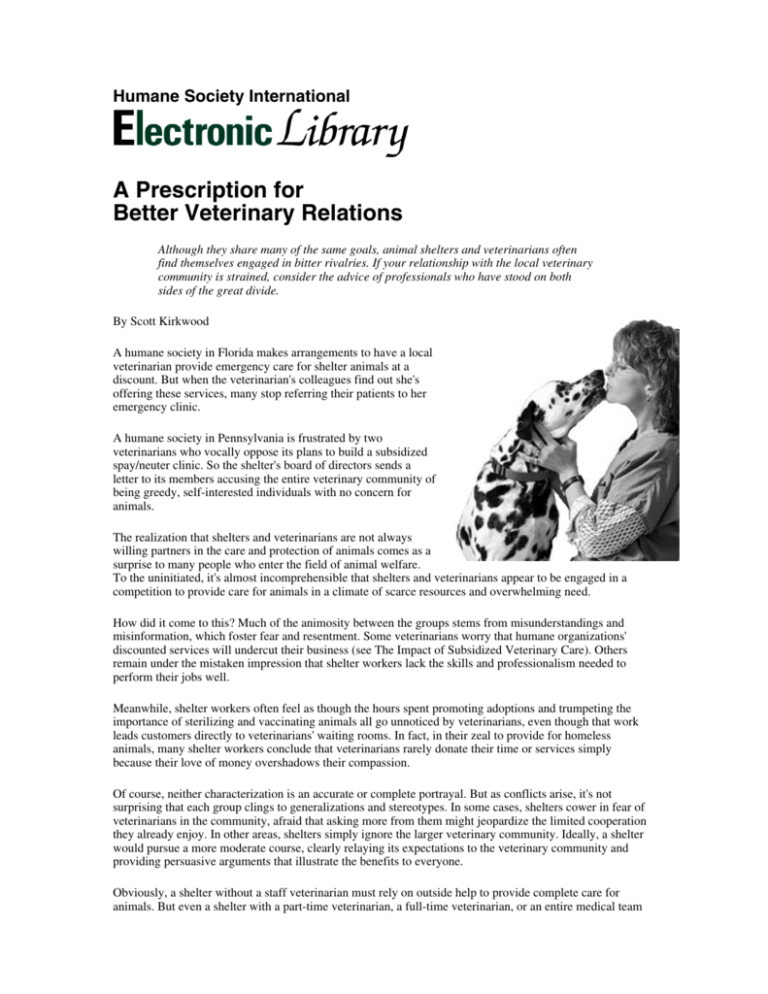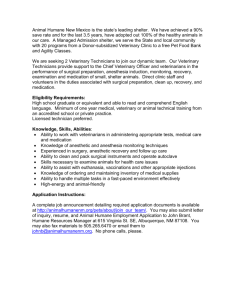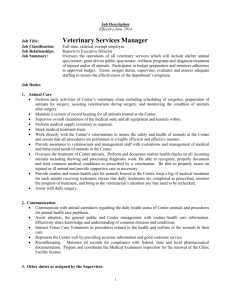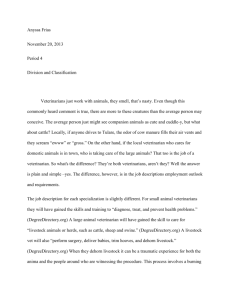
Humane Society International
A Prescription for
Better Veterinary Relations
Although they share many of the same goals, animal shelters and veterinarians often
find themselves engaged in bitter rivalries. If your relationship with the local veterinary
community is strained, consider the advice of professionals who have stood on both
sides of the great divide.
By Scott Kirkwood
A humane society in Florida makes arrangements to have a local
veterinarian provide emergency care for shelter animals at a
discount. But when the veterinarian's colleagues find out she's
offering these services, many stop referring their patients to her
emergency clinic.
A humane society in Pennsylvania is frustrated by two
veterinarians who vocally oppose its plans to build a subsidized
spay/neuter clinic. So the shelter's board of directors sends a
letter to its members accusing the entire veterinary community of
being greedy, self-interested individuals with no concern for
animals.
The realization that shelters and veterinarians are not always
willing partners in the care and protection of animals comes as a
surprise to many people who enter the field of animal welfare.
To the uninitiated, it's almost incomprehensible that shelters and veterinarians appear to be engaged in a
competition to provide care for animals in a climate of scarce resources and overwhelming need.
How did it come to this? Much of the animosity between the groups stems from misunderstandings and
misinformation, which foster fear and resentment. Some veterinarians worry that humane organizations'
discounted services will undercut their business (see The Impact of Subsidized Veterinary Care). Others
remain under the mistaken impression that shelter workers lack the skills and professionalism needed to
perform their jobs well.
Meanwhile, shelter workers often feel as though the hours spent promoting adoptions and trumpeting the
importance of sterilizing and vaccinating animals all go unnoticed by veterinarians, even though that work
leads customers directly to veterinarians' waiting rooms. In fact, in their zeal to provide for homeless
animals, many shelter workers conclude that veterinarians rarely donate their time or services simply
because their love of money overshadows their compassion.
Of course, neither characterization is an accurate or complete portrayal. But as conflicts arise, it's not
surprising that each group clings to generalizations and stereotypes. In some cases, shelters cower in fear of
veterinarians in the community, afraid that asking more from them might jeopardize the limited cooperation
they already enjoy. In other areas, shelters simply ignore the larger veterinary community. Ideally, a shelter
would pursue a more moderate course, clearly relaying its expectations to the veterinary community and
providing persuasive arguments that illustrate the benefits to everyone.
Obviously, a shelter without a staff veterinarian must rely on outside help to provide complete care for
animals. But even a shelter with a part-time veterinarian, a full-time veterinarian, or an entire medical team
must rely on the larger veterinary community to sterilize owned animals and help during emergencies.
Moreover, a recent survey by the American Pet Products Manufacturers Association reveals that 70 percent
of dog owners and cat owners rely on veterinarians for important information regarding their pets, while
only six percent rely on shelter personnel. If you can work with a group of such respected professionals to
deliver messages about responsible pet care, your job will obviously be much easier.
Likewise, veterinarians in private practice can benefit from a relationship with a shelter by acquiring clients
who have just adopted a pet, collaborating on public spay/neuter appeals, and even partnering to promote
the general health and safety of animals in the community. After all, veterinarians who promote the cause
of animal protection may very well find fewer boxes of puppies left at their clinic's doorstep and may
receive fewer phone calls from people complaining about free-roaming cats. Still, veterinarians can survive
and even thrive without close ties to local shelters. So it may be up to you to open the door and convince
veterinarians that keeping that door open is in everyone's best interests.
There Must Be Some Misunderstanding
In nearly every case of conflict, whether between two young siblings or two warring countries, the source
of the problem is failed communication. In most cases, the solution lies in reestablishing that
communication, finding common ground, and learning to appreciate the other party's needs, concerns, and
goals. That's not to say that simply discussing problems will make them melt away, only that
communication will beat a path toward understanding, a starting point for conflict resolution.
Approaches used to solve conflicts between shelters and veterinarians will differ depending on the history
of the participants, the goals of the shelter, and the veterinary community's presence in your area. Once
you've taken a closer look at the cards in your hand, you can reach out to veterinarians with a few
approaches successfully implemented by other humane organizations.
Before you pick up the phone or invite yourself to the next meeting of the local veterinary medical
association, consider your shelter's mission with respect to the veterinary community. Examine the goals
your board of directors has established, review your long-range plan, then consider how your pursuits
require the assistance of the veterinary community and how those pursuits might affect veterinarians. If
your programs are clearly defined, your work with every other group in the community will be more
effective. Without a well-crafted plan of action, your accomplishments will be limited no matter how many
others join you in the effort.
If a local veterinary clinic offers to provide discounted emergency care for shelter animals, you'll need to
establish a fee structure and a contact person to make those critical life-and-death decisions. If the clinic's
medical team has to place dozens of phone calls before taking action, the staff may become frustrated and
resentful. Similarly, if your program to increase licensing rates lacks a solid plan and detailed goals, don't
be surprised if a few veterinarians balk at the suggestion that they participate.
Hello, My Name Is . . .
Whether you're unfamiliar with most veterinarians in the community or struggling to overcome a difficult
history with a few private practitioners, the first step toward establishing a healthy relationship is to step
away from the organizational labels attached to animal shelters and veterinary clinics, and focus on one
person at a time.
"You can't have a relationship between an animal control agency and a veterinary medical association or a
humane society and a veterinary clinic; it has to be between individuals within the organization and
individuals within the veterinary community," says Bonnie Yoffe-Sharp, veterinarian with the City of Palo
Alto Animal Services Division. That relationship doesn't even have to begin with a veterinarian: "If the
receptionist with a local clinic adopted a dog from your shelter and that dog is the love of her life, you
already have a personal relationship and that can act as an introduction to the veterinary community," says
Yoffe-Sharp.
If new veterinarians set up shop nearby or if you just have yet to meet some of the established ones in your
community, don't be afraid to take the first step by picking up the phone. At the same time, Yoffe-Sharp
recommends setting up a "liaison committee" to discuss certain issues with veterinarians. Regular meetings
involving the shelter's animal care team, executive director, and a few local practitioners can lead to
productive discussions of important local issues and possible collaboration.
"If you work with somebody on a project of interest to both parties, and you have some sort of
misunderstanding later," says Yoffe-Sharp, "you'll feel comfortable picking up the phone and saying,
'Bonnie, what's the deal with this?' rather than just bad-mouthing that person and allowing rumors to spread
out of control." At the Peninsula Humane Society, Yoffe-Sharp's former employer, this kind of
communication led to veterinary participation in subsidized vaccination clinics for pet owners who had
never seen a veterinary professional before.
In Clearwater, Florida, the Humane Society of North Pinellas has met several times with breed-placement
groups, veterinarians, and other animal advocates to promote the cause of animals collectively. Dubbed
"Pet Partners," the group meets two or three times a year to discuss participants' respective projects and to
consider the possibility of collaborating on larger projects. This year, the group coordinated events for Spay
Day USA and also came up with plans to help pet owners in the event of a hurricane or tropical storm.
Of course, it helps if you start small. There may already be a handful of veterinarians who are friendly to
your cause and who wouldn't mind meeting for an hour or two every so often. Invite these individuals to
the first few meetings so you have a solid base to expand on, then slowly start to reach out to other
veterinarians who may be less familiar with your cause.
Try Their Shoes on for Size
Because those who work for humane
organizations constantly battle animal
homelessness, pet overpopulation, abuse, and
neglect, some are quick to question the
commitment of those outside their circle. And
because the work of veterinarians is so closely
linked to the mission of shelters, shelter workers
are often frustrated when veterinarians hesitate
to commit themselves to animal protection in the
same way. If your shelter has any interest in
working with the veterinarians in your
community, however, you'll need to broaden
your perspective and see their point of view.
Think twice before confronting a veterinarian
who doesn't offer to participate in a vaccination
clinic or refuses to offer her surgical skills at a
discounted rate. After all, each veterinarian must
be a businessperson first and an animal advocate
second.
"Let's not start by calling each other names,"
says Laurie Green, president of the Southern
Alliance for Animal Welfare, a small
organization that coordinates occasional
sterilization and vaccination clinics for pet
owners in Nashville, Tennessee. Green asks
shelter workers to consider how they might
respond if a veterinarian insisted their
organization wasn't doing enough for animals.
You can only do so much, and the same goes for
veterinarians. "You may have one or two
veterinarians who just want to be combative,"
says Green. "But give them a chance first."
©Peter Casella
Whether you ask for help diagnosing an animal's
medical condition or simply discuss the issue of freeroaming cats, you'll find that soliciting the opinions
of veterinarians may help strengthen your shelter's
relationship with them.
Because Green has treated veterinarians with respect and listened to what they have to say, she's had the
chance to hear exactly what they think about the issue of subsidized veterinary care. And the responses
might surprise some: One veterinarian recently told Green that he was glad she provided subsidized care
for low-income pet owners because otherwise those clients' names would have simply ended up in the
hands of his collection agency. Another veterinarian revealed that he hated turning needy people away from
his clinic, but he had to draw the line somewhere or risk going out of business.
While some veterinarians are glad to see subsidized care, others are a little more leery. But is it really
surprising that a small business owner is threatened when an organization steps in and offers identical
services for a price that's subsidized by donations?
Anything that could potentially affect a veterinarian's bottom line is understandably going to be viewed as a
threat. And veterinarians who own a practice are even more likely to rise up in protest, especially if that
practice is teetering on profitability. But more often than not these quite reasonable concerns are
misunderstood or downplayed by those who see veterinarians as selfish individuals whose concern for the
dollar outweighs their concern for animals.
"Veterinarians work very hard to get into school and commit themselves to a profession that doesn't
financially reward them the way some other medical professions might," says Michael Moyer, VMD,
former director of the Chester County SPCA in Pennsylvania. Most veterinarians enter the field with
thousands of dollars of personal debt thanks to the skyrocketing costs of their education. Meanwhile,
because of a shortage of qualified veterinary technicians, salaries for those professionals are rising,
contributing to the expense of running a practice. According to veterinarians, the cost of new prescription
drugs is growing and profit margins are shrinking as corporate giants such as VETsMART take a share of
the market.
"Veterinarians shouldn't be surprised to learn we make less than physicians, dentists, or even
chiropractors," says Moyer. "But we work very hard . . . and to feel as though our income-producing ability
might be reduced or competed away by someone who accuses us of being selfish is a tough pill to swallow.
It's as if we don't love pets because we make our living at it."
As a former shelter director, Moyer believes subsidized sterilization clinics will always be an important
part of helping pet owners in need. But he says shelters that try to counter overpopulation with nothing
more than subsidized sterilization clinics are missing the boat and aggravating veterinarians at the same
time. And research supports his claim. According to a pair of studies, one commissioned by the
Massachusetts SPCA and another by The HSUS, cost is not always the most important factor affecting pet
owners' decisions to sterilize pets (see the May 1993 issue of Shelter Sense). Many pet owners feel that
sterilization is an unnecessary procedure or an inconvenience, and some are still convinced it's inhumane.
As a shelter director, Moyer saw the importance of a broader approach to combatting pet overpopulation
while speaking to a local veterinarian who had dropped out of a program to sterilize animals belonging to
the general public. "He told me, 'I stopped participating in the program the day a woman dropped off a
three-year-old dog for a spay and I watched her walk out to her $35,000 BMW to drive back home. . . . I'm
just about breaking even or losing a little money to do the operation for the shelter at that fee, and I'm sure
not going to do it for bargain hunters.' " Stories like this may be rare, but if they play themselves out in a
veterinary clinic even once or twice, it's not surprising that any veterinarian might turn down an invitation
to offer discounted services.
Broaden Your Perspective
To strengthen your relationship with veterinarians and effectively double the impact of your message, take
a broader look at the issues surrounding sterilization. "If you're asking veterinarians to lose some of their
income so the shelter can feel good about its programs, they're not going to buy into it, " says Moyer. "But
if shelters can step back and accept the fact that people choose not to sterilize their animals for a variety of
reasons having nothing to do with economics, you'll get total veterinary buy-in and support for all of the
other reasons, including health [and behavior issues]." And if your shelter is able to offer subsidized care to
pet owners from every economic background to encourage wider participation, complement that work by
stressing the importance of timely check-ups, vaccinations, and all of the other vital services performed by
veterinarians.
Sometimes by simply giving veterinarians the benefit of the doubt, you'll get more cooperation than you
might think. In Tampa, Florida, recent headlines in the local newspaper portrayed a battle between area
veterinarians and the Humane Society of Tampa Bay over the building of a spay/neuter clinic and the
allocation of government funds to subsidize spay/neuter surgeries. But the humane society's executive
director, Kris Murphy, recognizes that a small but vocal minority of veterinarians lead the protests while
dozens of others support the program. "Some of the veterinarians have been on our side from the
beginning," says Murphy. "They've even called me up and said, 'You're right. The [pet overpopulation]
problem is awful and something needs to be done.' "
In fact, when the local veterinary association called a special emergency session to discuss the shelter's
intention to establish a spay/neuter clinic, only a handful of veterinarians showed up. And although the
local veterinary medical association decided not to back Spay Day USA earlier this year, participation
among veterinarians was greater than ever.
Ask for Their Two Cents
Another effective way to strengthen your
relationship with local veterinarians is to solicit
their professional advice on issues that impact
animals in the community. Whether you ask for
an opinion on the future of chemical sterilization
or details on the best veterinary medical supply
company, you may receive a lot more than an
answer to your question.
"Everybody loves to have their opinions asked,"
says Yoffe-Sharp. "Whether it's on politics or
how to get a stain out of a shirt, when you ask
for someone's opinion, you're giving them a
gift—you're saying, 'I respect you... I care what
you think,' and that really opens up a dialogue."
It also gives you an opportunity to learn from
©Bonnie Smith
other experts in the field of animal care. That's
not to say you'll follow every suggestion that
local veterinarians recommend, only that you'll
Although shelters most often associate veterinarians
take their comments into consideration before
with spay/neuter programs, humane agencies can
moving forward. "Let them know from ground
benefit from cooperation with veterinarians on many
animal-related issues.
zero what the organization is going to do, and
involve them in the planning," says YoffeSharp. "Ask them, 'If we're going to [pursue this
program], what's the right way, what expertise do we need...?' Let them know it's not a matter of doing it or
not—you're already planning to do it—but it's a matter of doing it the right way."
Don't ask for someone's opinion on a matter if you've already made up your mind, warns Yoffe-Sharp,
because pursuing that course in spite of their objections will only show them you were never really
listening. Are you worried that the veterinarians in your region will be unwilling to lend the time or
expertise to respond to your query? That's not likely. In fact, veterinarians will probably be taken aback if
you fail to ask for their thoughts on a program that might affect their work. One veterinarian interviewed
for this article expressed frustration at the fact that the nearest shelter had never solicited an opinion on any
matter regarding animals in the community.
Not surprisingly, many sheltering professionals suggest that limiting your communication and keeping your
plans under wraps is the best way to prevent veterinarians from meddling. Such an approach may
occasionally work in a shelter's favor in the short term, but it's not likely to engender trust and respect in the
long run. If veterinarians have advance notice of your plans and strongly disagree with your goals, there's
no reason you should allow them to derail those plans (see "You Can Go Your Own Way" section on page
5 of this article). On the other hand, if you're open to their comments and concerns, you may receive some
worthy suggestions.
"Give them a way to help you," says Green. "Approach [veterinarians by saying], 'I know you all want to
help, and I know you all care about the situation...and this is what I'm doing..." When Green began
coordinating her group's program to sterilize animals owned by low-income residents in the area, she
solicited the opinion of John McCormick, DVM, president of the Davidson County Veterinary Association.
After faxing drafts of the application, press release, and promotional flyer announcing the event, Green
encouraged the doctor to provide input. The first clinic went off without a hitch, but prior to the second
clinic, the local newspaper inadvertently omitted a special notice restricting the invitation to low-income
residents. Green immediately called the veterinarian to explain the situation and apologize for the problem.
But because McCormick had seen how open and forthright she'd been in the past, he never thought the
omission was anything but an accident.
What's Goin' On?
Once you've established contact with veterinarians, ongoing communications will nurture those budding
relationships, help you solve problems together, and even prevent misunderstandings. "If somebody adopts
a kitten from the shelter and the animal starts sneezing two days later, the local veterinarians might think
that the shelter doesn't know what they're doing, that they just put out sick animals," says Yoffe-Sharp. To
combat this perception, shelters should let veterinarians know that the problems result from the population
density, the number of cats coming in with unknown histories, and the likelihood that incoming animals are
incubating disease.
"Most shelters are doing a good job trying to isolate animals, vaccinate and treat them, and disinfect
properly," says Yoffe-Sharp, "but if you have a big outbreak you might even write a letter: 'Dear
colleagues: We're experiencing a lot of upper respiratory infections in the shelter recently...This is our
disinfecting protocol and our vaccination protocol....Please let me know if you're seeing a large number of
affected animals, and give us a call if you have any ideas to help us decrease the incidence.'" This
correspondence lets veterinarians know you're doing a thorough job. It also shows them that you're open to
any advice they might offer, and that appeal might elicit some worthwhile suggestions.
Think Bigger
These one-on-one interactions will arise often, whether you're following up on an animal's spay/neuter
surgery or calling to see if a prospective adopter has up-to-date vaccinations for the pets he already has. But
it's also important to reach out to the veterinary community as a whole.
"Staying in contact with the local veterinary medical association is so important," says Rob Hoffman,
veterinarian for the Arizona Animal Welfare League and former veterinarian for the San Francisco
Department of Animal Care and Control. "In San Francisco, the private veterinarians saw many of our
animals, so every year I would write an update of what vaccines we used, what brands, how often they
were administered, how we treated earmites, how we treated fleas, and all of those things. [That way, the
veterinarians] would be prepared before clients came through their doors." Once a year, Hoffman invited
every veterinarian to take a tour of the shelter to see how the facility operated.
The Virginia Beach SPCA has formalized communications with veterinarians by mailing out a survey each
year. Executive Director Sharon Adams introduces the survey with a letter recognizing the veterinarian's
role in the community and a reminder that the shelter encourages new adopters to visit a veterinarian.
Questions on the survey gauge the veterinarian's understanding of shelter procedures and explore the new
clients' knowledge of the animal they've adopted. After receiving responses from veterinarians—albeit
fewer than she might have liked—Adams recognized that there was widespread confusion regarding the
shelter's practice of screening for heartworm and feline leukemia. A follow-up mailing clarified these
protocols and explained the information contained on forms that new adopters bring to initial exams.
Phone calls and surveys may be the most convenient methods of communication, but Yoffe-Sharp
also suggests every shelter try to send a representative to occasional meetings of the veterinary medical
association as well. "Even if the meetings are in the evenings and you're tired, make an effort to go
because then you're someone people see every other month at the local meeting versus a name with
no face," she says.
She also encourages veterinarians working at shelters to volunteer for administrative positions within the
association. Organizers often have a difficult time finding someone to fill these posts, but the positions
rarely require an enormous contribution of time and often provide great opportunities for exposure and
networking. You might even suggest an occasional column in the association's newsletter to discuss topics
such as rabies quarantine regulations, early-age spay/neuter, and other issues important to veterinarians but
not intimately linked to their day-to-day existence.
Use your own newsletter to transmit information to the veterinary community, too. Take the time to add
local veterinarians to your list of newsletter subscribers, so they know what activities you're pursuing on a
regular basis. If your shelter is holding a special adoptathon, for instance, veterinarians might be willing to
pass the word on to their clients. And rather than simply addressing the newsletter to "Clinic," print the
name of the head veterinarian or office manager on the address label for a personal touch.
You might even ask one or two veterinarians to put their names on the inside of your newsletter by
contributing an occasional article on basic pet care. Even if you already have your own resident experts on
animal behavior and medical issues, it often helps to add a new voice to the mix and give local
veterinarians an opportunity to address pet owners and court potential clients.
You can also use the pages of your shelter newsletter and Web site to thank veterinarians for their work.
Shelters such as the Riverside Humane Society in Riverside, California, occasionally run lengthy profiles
of veterinarians who donate time and expertise. What veterinarian wouldn't enjoy being highlighted in a
publication sent to hundreds or even thousands of pet lovers? Shelter directors who have spent the time to
create special certificates of appreciation for helpful veterinarians have reported seeing framed copies
hanging on the walls of the clinic's lobby years later.
While it's important to thank veterinarians for the work they do for your shelter, it's just as important to
remind them of the work you're doing for them. If your organization is launching an advertising campaign
touting the importance of sterilization, let local veterinarians know what you're up to. If you're trying to
promote licensing and rabies vaccinations, let veterinarians know how much money you're spending on the
project. If your shelter encourages adopters to select a veterinarian to perform spay/neuter surgeries or a
free initial medical consultation, ask them to let you know which veterinarian they plan to visit, then
forward their names to the appropriate clinic. Each week veterinarians will be able to see clear evidence of
the business you're sending their way; ambitious veterinarians might even call adopters who haven't gotten
around to making an appointment.
Like a Good Neighbor
How important is it to invite veterinarians to get a
glimpse of the work your shelter does every day?
Remember that few veterinarians have any
experience with a shelter during veterinary school,
and many stumble upon their shelter experiences
quite accidentally. "I never set foot in a shelter until I
was doing relief work, and until then I'd pictured the
shelter as a dark, gray, horrible place for animals,"
says Yoffe-Sharp, who has spent 14 years working in
shelters. "The shelter ended up being so much nicer
than most of the hospitals I'd been working in. But a
lot of veterinarians have never set foot in the local
shelter—they don't know if there are ten dogs in
every cage or if each dog has an indoor/outdoor run."
©Laura Kipp
A certificate of appreciation is a meaningful
way to recognize the hard work and dedication
of a supportive veterinarian.
Get veterinarians into your facility any way you can, by offering a tour, showing off your new cat-caging
system, or holding a meeting. "Let them come away with a picture of the place," says Yoffe-Sharp, "so
when they're talking to their clients who had to put a beloved 14-year-old companion to sleep and are ready
for another dog, that veterinarian is more likely to say, 'Why don't you go down to the local shelter and talk
to them? They can really counsel you and they have some great animals there...' "
Kathy Bice, director of the Brazos Animal Shelter in Bryan, Texas, was attending a meeting of the Texas
Veterinary Medical Association when she first realized how important it was to get veterinarians into
her facility. "People thought that I was a volunteer and thought we were just little old ladies in 'tennies'
taking care of six dogs, when we actually have a staff of seventeen serving ten counties, with 10,000
animals a year."
To change that perception, Bice is reaching out to veterinarians before they even become veterinarians.
Situated only a few blocks away from Texas A&M's veterinary school, Brazos Animal Shelter has invited
students to spend time working in the shelter environment. The program requires a great investment of time
as well as the ongoing involvement of shelter staff, but the effort is paying off. Students administer
vaccines, and they perform spay/neuter surgeries on shelter animals under the supervision of a professor.
During their final year, they spend eight days in the shelter over a two-week period, studying microbiology
and parasitology. "Students learn about companion animal 'herd health,' rotate through euthanasia, and see
the whole decision-making process," says Bice. "The difference in attitudes is unbelievable: The veterinary
students used to come in with a chip on their shoulder and try to tell us how to do things, but now they
come in and know we're partners."
Bice recognizes, however, that the entire process isn't easy for either group: "It's a real risk to invite
someone into your shelter to work with you elbow-to-elbow for eight days in a row: They're going to see
you deal with euthanasia and you're going to have to deal with the grief," says Bice. "But when they spend
eight days here and they euthanize some of the animals they tested for disease three days ago, it gets
them.... It gets us."
Even if you don't have a university in your backyard, you still may be able to educate veterinarians about
aspects of your work that have a huge impact on their profession. For instance, you may be able to offer
advice to a clinic coping with the impact of upper respiratory infections or kennel cough. Better yet, you
might educate veterinarians on the connection between animal abuse and violence against humans, a
subject that has legal and ethical implications for veterinarians. As professionals working on the front lines
every day, veterinarians are in a position to identify and prevent abuse, and organizations like The HSUS
and American Humane Association can provide the educational materials your shelter needs to get
veterinarians actively involved.
In fact, by working on the issue of animal neglect and abuse, one shelter started the process of
reconciliation with the local veterinary community. After the Michigan Humane Society (MHS) established
full-service veterinary clinics to provide subsidized care, clashes between MHS and veterinarians were
commonplace (see The Impact of Subsidized Veterinary Care). But things started changing when the
organization and veterinarians teamed up on legislative efforts that advanced the cause of both groups.
"This is the era of collaboration," says Gary Tiscornia, MHS's executive director. "If you want to make
progress you've got to [work together.] It's simply a matter of building trust over time. We've worked on
animal fighting laws, we've taken a look at legislation that veterinarians are interested in to prevent animals
from being abandoned in their clinics. Now we really have a nice dialogue such that if we feel there is some
mutual interest, we float ideas out to each other to see if we can collaborate."
If You Lead, They May Follow
Obviously there will be many times that veterinarians believe their best interests don't coincide with your
shelter's plans. But before you arm yourself for a struggle, consider using more subtle forms of persuasion.
For instance, like most everyone, veterinarians are inclined to put a lot of stock in the opinions of friends
and colleagues, and that fact can work to a shelter's advantage. One animal control director was so in tune
to the peer pressure among veterinarians in her community that she cleverly used their competitive instinct
to her advantage. After inviting veterinarians to her shelter to discuss a proposal, she arranged all of the
chairs in a tidy circle and seated a shelter-friendly veterinarian to her right. When it came time to ask for
everyone's support, she began with the gentleman whose response she already knew. As soon as one doctor
agreed, the rest quickly fell in line.
Of course, some might consider a strategy such as this one a bit too manipulative, but it shows that even
if you can persuade only one veterinarian to step forward, dozens of others may follow suit. "If just one
individual gets more business, pretty soon they will all want to be on your list for a free post-adoption
exam or [follow-up care] for people who have problems beyond what can be done at a particular clinic,"
says Yoffe-Sharp.
And although the local veterinary medical association may present an obstacle at times, it just might be the
ideal group to approach for help. Whenever controversial questions arise in Brazos, Texas, veterinarians are
quick to solicit the opinion of the Brazos Valley Veterinary Medical Association, so Bice is savvy enough
to focus her initial efforts on the local association. "Even if there are only three or four people active in the
VMA and [few people] attend meetings, most veterinarians will participate in shelter programs if I go
through the motions of getting a project approved by the VMA."
You Can Go Your Own Way
The more cooperation you receive from local veterinarians, the better, but when cooperation seems out of
the question, you can't let veterinarians stand between you and your shelter's goals. If the majority of
veterinarians agree with the practice of pediatric spay/neuter, all the better for both parties; if not,
respectfully disagree with those veterinarians, try to find a veterinarian who will perform the surgery, then
move on.
"What veterinarians are doing and what they are about is completely different from shelters—they don't
have the same responsibilities, they don't have the same mission, they don't have the same
experiences...they are not us," says Adams, who has had her share of disagreements with area veterinarians,
but continues to earn the respect and support of many. "To allow veterinarians to dictate to SPCAs and
humane societies who and what they ought to be in their community is an abrogation of responsibility.
Decisions have to be made that are consistent with the fact that we are euthanizing healthy, adoptable
animals and they are not. If you have to make a decision that doesn't necessarily fit with what a veterinarian
might say or do, that's fine, as long as it's consistent with your mission and your experience. To do any less
is unconscionable."
The Virginia Beach SPCA's battles with the veterinary community are well documented (see The Impact of
Subsidized Veterinary Care), and Adams and her staff continue to push the envelope. When the shelter staff
realized that many adopters were violating their adoption contracts and failing to bring their animals to
veterinarians for spay/neuter surgery, Adams decided sterilization-at-adoption was the only alternative. So
she invited herself to a meeting of the Southhampton Veterinary Community Association, showed the
veterinarians all the contracts from animals who had gone unsterilized, and discussed the likelihood that her
staff was euthanizing the offspring of these adopted animals. Then she left the veterinarians with two
choices—work out an agreement to sterilize animals before adoption or allow the shelter to do so without
interfering. When she was greeted with silence, plans to create an in-shelter surgical suite moved forward.
Since then, the shelter has sterilized more than 12,000 animals prior to adoption.
As the shelter begins plans to open a spay/neuter clinic for the general public, Adams is already bracing for
a battle with the veterinary community. The budget includes funding not only for a surgical suite, but also
for confronting the legal challenge that will likely come from veterinarians. The last time the shelter went
against the veterinary association's wishes, veterinarians threatened to boycott drug companies that sold
products to the shelter, so Adams and her associates are planning to stockpile plenty of pharmaceutical
products in case the story plays itself out again.
Shelters may be risking something when they decide that fulfilling their mission is more important than
pleasing the veterinary community, but it's important to remember the influence that your shelter has. If
your organization has a say in local animal protection legislation, acts as a regular media contact, and
coordinates hundreds or even thousands of adoptions a year, you may have more power than you realize.
When public relations battles arise, the shelter usually has the upper hand because of its role as an advocate
for animals.
That's not to say that wielding idle threats is an acceptable way to get what you want, only that when
conflicts heat up and negotiations begin, shelters have as much at stake and as much control over their own
fates as any veterinarian. Your knowledge of the community and an honest appraisal of your influence
should guide everything you do. But regardless of the stance you take on a particular issue, remember to
limit discussions to the issues. If your shelter starts attacking individual veterinarians or claiming that the
veterinary community doesn't care about animals, the public may lose respect for both your shelter and the
veterinarians. If you can respectfully disagree with one another, you'll guarantee that future opportunities
aren't lost.
Copyright 1999 The Humane Society of the United States.
All rights reserved.







